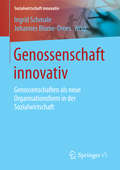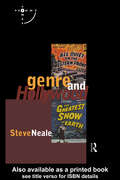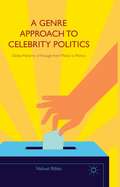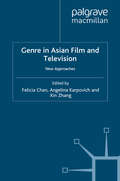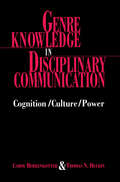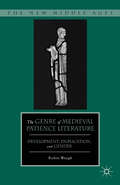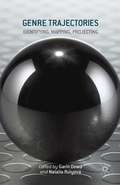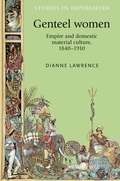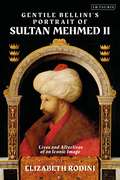- Table View
- List View
Genossenschaft innovativ: Genossenschaften als neue Organisationsform in der Sozialwirtschaft (Sozialwirtschaft innovativ)
by Ingrid Schmale Johannes Blome-DreesDieser Band gibt einen Überblick über den begrifflichen und konzeptionellen Bezugsrahmen, in dem aktuell Wissenschaftler Sozialgenossenschaften verorten und diskutieren. Der rechtliche Rahmen – Genossenschaftsgesetz sowie die Sozialgesetzgebung – werden in ihrer rahmensetzenden Wirkung ausgelotet. Praxisbeispiele wirken überblickgebend, illustrierend und anregend für eigene, praxisorientierte Initiativen, aber auch für die wissenschaftliche Auseinandersetzung mit den Beiträgen genossenschaftlicher Akteure im Bereich der Sozialen Dienste. Ein Blick in das europäische Ausland, z.B. nach Italien oder Schweden, zeigt, wie günstige Rahmenbedingungen die Entwicklung von Sozialgenossenschaften stark nach vorne bringen.
Genre and Hollywood
by Steve NealeGenre and Hollywood provides a comprehensive introduction to the study of genre. In this important new book, Steve Neale discusses all the major concepts, theories and accounts of Hollywood and genre, as well as the key genres which theorists have written about, from horror to the Western. He also puts forward new arguments about the importance of genre in understanding Hollywood cinema.Neale takes issue with much genre criticism and genre theory, which has provided only a partial and misleading account of Hollywood's output. He calls for broader and more flexible conceptions of genre and genres, for more attention to be paid to the discourses and practices of Hollywood itself, for the nature and range of Hollywood's films to be looked at in more detail, and for any assessment of the social and cultural significance of Hollywood's genres to take account of industrial factors.In detailed, revisionist accounts of two major genres - film noir and melodrama - Neale argues that genre remains an important and productive means of thinking about both New and old Hollywood, its history, its audiences and its films.
Genre and Hollywood
by Steve NealeGenre and Hollywood provides a comprehensive introduction to the study of genre. In this important new book, Steve Neale discusses all the major concepts, theories and accounts of Hollywood and genre, as well as the key genres which theorists have written about, from horror to the Western. He also puts forward new arguments about the importance of genre in understanding Hollywood cinema.Neale takes issue with much genre criticism and genre theory, which has provided only a partial and misleading account of Hollywood's output. He calls for broader and more flexible conceptions of genre and genres, for more attention to be paid to the discourses and practices of Hollywood itself, for the nature and range of Hollywood's films to be looked at in more detail, and for any assessment of the social and cultural significance of Hollywood's genres to take account of industrial factors.In detailed, revisionist accounts of two major genres - film noir and melodrama - Neale argues that genre remains an important and productive means of thinking about both New and old Hollywood, its history, its audiences and its films.
Genre and Institutions: Social Processes in the Workplace and School
by Frances Christie J. R. MartinThis book examines genres as instances of social processes, enacting a range of important institutional practices, hence also shaping people's subjectivities. Genres represent purposive and staged ways of building means in a culture. The book's particular claim to originality is that, using systemic functional grammar, it demonstrates how given genres build or enact social practice, how educational setting provide contexts in which some apprenticeship into such genres occurs, and how theorizing about such matters helps build a theory of social action, revealing how powerful is the systemic functional analysis in addressing questions concerning the social construction of reality.The discussion is built around extensive analysis of instances of texts collected in a number of worksites and school settings. While most are instances of written genres, some are spoken, most notably the chapter that is devoted to the discussion of the spoken classroom texts in which the teaching and learning of the written genres take place.
Genre and Television: From Cop Shows to Cartoons in American Culture
by Jason MittellGenre and Television proposes a new understanding of television genres as cultural categories, offering a set of in-depth historical and critical examinations to explore five key aspects of television genre: history, industry, audience, text, and genre mixing. Drawing on well-known television programs from Dragnet to The Simpsons, this book provides a new model of genre historiography and illustrates how genres are at work within nearly every facet of television-from policy decisions to production techniques to audience practices. Ultimately, the book argues that through analyzing how television genre operates as a cultural practice, we can better comprehend how television actively shapes our social world.
Genre and Television: From Cop Shows to Cartoons in American Culture
by Jason MittellGenre and Television proposes a new understanding of television genres as cultural categories, offering a set of in-depth historical and critical examinations to explore five key aspects of television genre: history, industry, audience, text, and genre mixing. Drawing on well-known television programs from Dragnet to The Simpsons, this book provides a new model of genre historiography and illustrates how genres are at work within nearly every facet of television-from policy decisions to production techniques to audience practices. Ultimately, the book argues that through analyzing how television genre operates as a cultural practice, we can better comprehend how television actively shapes our social world.
A Genre Approach to Celebrity Politics: Global Patterns of Passage from Media to Politics
by Nahuel RibkeExploring the transition of celebrities into institutional-electoral politics, the book argues that many insights developed by genre theorists could be highly instrumental to understand the celebrity politics phenomenon. It analyzes the historical and cultural specificity of celebrity politics as it evolved through different countries and cultures.
Genre in Asian Film and Television: New Approaches
by Felicia Chan Angelina KarpovichGenre in Asian Film and Television takes a dynamic approach to the study of Asian screen media previously under-represented in academic writing. It combines historical overviews of developments within national contexts with detailed case studies on the use of generic conventions and genre hybridity in contemporary films and television programmes.
Genre Knowledge in Disciplinary Communication: Cognition/culture/power
by Carol Berkenkotter Thomas N. HuckinAlthough genre studies abound in literary criticism, researchers and scholars interested in the social contexts of literacy have recently become interested in the dynamic, rhetorical dimensions of speech genres. Within this burgeoning scholarly community, the authors are among the first researchers working within social science traditions to study genre from the perspective of the implicit knowledge of language users. Thus, this is the first sociocognitive study of genre using case-study, naturalistic research methods combined with the techniques of rhetorical and discourse analysis. The term "genre knowledge" refers to an individual's repertoire of situationally appropriate responses to recurrent situations -- from immediate encounters to distanced communication through the medium of print, and more recently, the electronic media. One way to study the textual character of disciplinary knowledge is to examine both the situated actions of writers, and the communicative systems in which disciplinary actors participate. These two perspectives are presented in this book. The authors' studies of disciplinary communication examine operations of systems as diverse as peer review in scientific publications and language in a first grade science classroom. The methods used include case study and ethnographic techniques, rhetorical and discourse analysis of changing features within large corpora and in the texts of individual writers. Through the use of these techniques, the authors engaged in both micro-level and macro-level analyses and developed a perspective which reflects both foci. From this perspective they propose that what micro-level studies of actors' situated actions frequently depict as individual processes, can also be interpreted -- from the macro-level -- as communicative acts within a discursive network or system. The research methods and the theoretical framework presented are designed to raise provocative questions for scholars, researchers, and teachers in a number of fields: linguists who teach and conduct research in ESP and LSP and are interested in methods for studying professional communication; scholars in the fields of communication, rhetoric, and sociology of science with an interest in the textual dynamics of scientific and scholarly communities; educational researchers interested in cognition in context; and composition scholars interested in writing in the disciplines.
Genre Knowledge in Disciplinary Communication: Cognition/culture/power
by Carol Berkenkotter Thomas N. HuckinAlthough genre studies abound in literary criticism, researchers and scholars interested in the social contexts of literacy have recently become interested in the dynamic, rhetorical dimensions of speech genres. Within this burgeoning scholarly community, the authors are among the first researchers working within social science traditions to study genre from the perspective of the implicit knowledge of language users. Thus, this is the first sociocognitive study of genre using case-study, naturalistic research methods combined with the techniques of rhetorical and discourse analysis. The term "genre knowledge" refers to an individual's repertoire of situationally appropriate responses to recurrent situations -- from immediate encounters to distanced communication through the medium of print, and more recently, the electronic media. One way to study the textual character of disciplinary knowledge is to examine both the situated actions of writers, and the communicative systems in which disciplinary actors participate. These two perspectives are presented in this book. The authors' studies of disciplinary communication examine operations of systems as diverse as peer review in scientific publications and language in a first grade science classroom. The methods used include case study and ethnographic techniques, rhetorical and discourse analysis of changing features within large corpora and in the texts of individual writers. Through the use of these techniques, the authors engaged in both micro-level and macro-level analyses and developed a perspective which reflects both foci. From this perspective they propose that what micro-level studies of actors' situated actions frequently depict as individual processes, can also be interpreted -- from the macro-level -- as communicative acts within a discursive network or system. The research methods and the theoretical framework presented are designed to raise provocative questions for scholars, researchers, and teachers in a number of fields: linguists who teach and conduct research in ESP and LSP and are interested in methods for studying professional communication; scholars in the fields of communication, rhetoric, and sociology of science with an interest in the textual dynamics of scientific and scholarly communities; educational researchers interested in cognition in context; and composition scholars interested in writing in the disciplines.
The Genre of Medieval Patience Literature: Development, Duplication, and Gender (The New Middle Ages)
by R. WaughThis book examines evolution of medieval patience literature from a focus on male and female sufferers to a focus on female suffers in particular. Using feminist revisions of genre-theory, Waugh analyses the concept of counterfeit consciousness in the works of Margery Kempe and Chaucer among others.
Genre Studies in Mass Media: A Handbook
by Art SilverblattThe study of various types of programming is essential for critical analysis of the media and also offers revealing perspectives on society's cultural values, preoccupations, behavior, and myths. This handbook provides a systematic, in-depth approach to the study of media genres - including reality programs, game shows, situation comedies, soap operas, film noir, news programs, and more. The author addresses such questions as: Have there been shifts in the formula of particular genres over time? What do these shifts reveal about changes in culture? How and why do new genres - such as reality TV shows - appear? Are there differences in genres from one country to another? Combining theoretical approaches with concrete examples, the book reinforces one's understanding of the importance of genre to the creation, evolution, and consumption of media content. Each chapter in this reader-friendly book contains a detailed discussion of one of the theoretical approaches to genre studies, followed by Lines of Inquiry, which summarizes the major points of the discussion and suggests directions for analysis and further study. Each chapter also includes an example that illustrates how the particular theoretical approach can be applied in the analysis of genre. The author's careful linkage of different genres to the real world makes the book widely useful for those interested in genre study as well as media and culture, television studies, film studies, and media literacy.
Genre Studies in Mass Media: A Handbook
by Art SilverblattThe study of various types of programming is essential for critical analysis of the media and also offers revealing perspectives on society's cultural values, preoccupations, behavior, and myths. This handbook provides a systematic, in-depth approach to the study of media genres - including reality programs, game shows, situation comedies, soap operas, film noir, news programs, and more. The author addresses such questions as: Have there been shifts in the formula of particular genres over time? What do these shifts reveal about changes in culture? How and why do new genres - such as reality TV shows - appear? Are there differences in genres from one country to another? Combining theoretical approaches with concrete examples, the book reinforces one's understanding of the importance of genre to the creation, evolution, and consumption of media content. Each chapter in this reader-friendly book contains a detailed discussion of one of the theoretical approaches to genre studies, followed by Lines of Inquiry, which summarizes the major points of the discussion and suggests directions for analysis and further study. Each chapter also includes an example that illustrates how the particular theoretical approach can be applied in the analysis of genre. The author's careful linkage of different genres to the real world makes the book widely useful for those interested in genre study as well as media and culture, television studies, film studies, and media literacy.
Genre Trajectories: Identifying, Mapping, Projecting
by Garin Dowd Natalia RulyovaThis book provides a fresh interdisciplinary perspective on genre and identifies developments in genre studies in the early 21st century. Genre approaches are applied to examine a fascinating range of texts including ancient Greek poems, Holocaust visual and literary texts, contemporary Hollywood films, selfies, melodrama, and classroom practices.
Genre und Race: Mediale Interdependenzen von Ästhetik und Politik (Neue Perspektiven der Medienästhetik)
by Irina Gradinari Ivo RitzerDie Kategorie Race gewinnt aktuell wieder stärker an politischer Sichtbarkeit, bedingt vor allem durch die Black-Lives-Matter-Bewegung, Migration und Flucht, nicht zuletzt auch durch Theorieansätze wie Postcolonial Studies, Critical Race Theory, Intersektionalität oder Decolonizing der Gender Studies. Vor diesem Hintergrund gilt es zunächst medienspezifische Strategien in ihrer Vielfalt sowie historischen Entwicklung kritisch zu befragen, die zu rassistischem Denken und rassistischer Politik beigetragen haben und bis heute beitragen. Die Kategorie Genre als eine ambivalente und komplexe Wahrnehmungs- und Sinngebungsstruktur an der Schnittstelle von Produktion, Rezeption und Ästhetik bietet sich besonders an, um sich medientechnologischen Traditionen und Mitteln anzunähern, die Race politisch wirksam machen, verschiedene Ideologien bedienen, Affekte produzieren und zugleich jedoch immer auch Widerstände oder neue Sichtweisen und Artikulationsformen hervorbringen. Der Band versammelt unterschiedliche theoretische und analytische Ansätze, die anhand ausgewählter Gegenstände Einblicke in die Geschichte des Wechselbezugs von Genre und Race gewähren sowie sich mit dessen internationaler und nationalspezifischer Akzentuierung beschäftigen, wobei stets grundsätzliche Fragen nach dem Verhältnis von Visualität und Race sowie die epistemologische Kraft des Blickes im Fokus stehen.Mit Beiträgen von Lisa Andergassen, Thomas Bedorf, Julia Bee, Kyung-Ho Cha, Julia Dittmann, Irina Gradinari, Irmtraud Hnilica, Karina Kirsten, Michaela Ott, Johannes Pause, Nele Rein, Ivo Ritzer, Drehli Robnik, Peter Scheinpflug und Michaela Wünsch.
Genre und Videospiel: Einführung in eine unmögliche Taxonomie (Genrediskurse)
by Felix SchnizDiese Monographie erläutert Videospiele als mehrdimensionale und zutiefst wandelsame Konzepte als Wechselspiel dreier Dimensionen: Neben den in genretheoretischen Hybridansätzen zwischen Fiktionsgenre und Spielgenre sind es nämlich auch soziale Genrekomplexe, welche die Erfahrung des Spielers, insbesondere in Multiplayerspielen prägen. Das Videospiel zeigt sich als objet ambigué: ein Kunstobjekt, das sich endlich im Prozess der Interaktion mit dem Nutzer neu offenbart und positioniert.
Genres of Privacy in Postwar America (Post*45)
by Palmer RampellWith this incisive work, Palmer Rampell reveals the surprising role genre fiction played in redefining the category of the private person in the postwar period. Especially after the Supreme Court established a constitutional right to privacy in 1965, legal scholars, judges, and the public scrambled to understand the scope of that right. Before and after the Court's ruling, authors of genre fiction and film reformulated their aliens, androids, and monsters to engage in debates about personal privacy as it pertained to issues like abortion, police surveillance, and euthanasia. Triangulating novels and films with original archival discoveries and historical and legal research, Rampell provides new readings of Patricia Highsmith, Dorothy B. Hughes, Philip K. Dick, Octavia Butler, Chester Himes, Stephen King, Cormac McCarthy, and others. The book pairs the right of privacy for heterosexual sex with queer and proto-feminist crime fiction; racialized police surveillance at midcentury with Black crime fiction; Roe v. Wade (1973) with 1960s and 1970s science fiction; the Child Abuse Prevention and Treatment Act (1974) with horror; and the right to die with westerns. While we are accustomed to defenses of fiction for its capacity to represent fully rendered private life, Rampell suggests that we might value a certain strand of genre fiction for its capacity to theorize the meaning of the protean concept of privacy.
Genres of Privacy in Postwar America (Post*45)
by Palmer RampellWith this incisive work, Palmer Rampell reveals the surprising role genre fiction played in redefining the category of the private person in the postwar period. Especially after the Supreme Court established a constitutional right to privacy in 1965, legal scholars, judges, and the public scrambled to understand the scope of that right. Before and after the Court's ruling, authors of genre fiction and film reformulated their aliens, androids, and monsters to engage in debates about personal privacy as it pertained to issues like abortion, police surveillance, and euthanasia. Triangulating novels and films with original archival discoveries and historical and legal research, Rampell provides new readings of Patricia Highsmith, Dorothy B. Hughes, Philip K. Dick, Octavia Butler, Chester Himes, Stephen King, Cormac McCarthy, and others. The book pairs the right of privacy for heterosexual sex with queer and proto-feminist crime fiction; racialized police surveillance at midcentury with Black crime fiction; Roe v. Wade (1973) with 1960s and 1970s science fiction; the Child Abuse Prevention and Treatment Act (1974) with horror; and the right to die with westerns. While we are accustomed to defenses of fiction for its capacity to represent fully rendered private life, Rampell suggests that we might value a certain strand of genre fiction for its capacity to theorize the meaning of the protean concept of privacy.
Genres of Recollection: Archival Poetics and Modern Greece (Anthropology, History and the Critical Imagination)
by P. Papalias Penelope PapailiasThis book brings to life the social and textual worlds in which the representation of contemporary Greek historical experience has been passionately debated, building on contemporary research in history and anthropology concerning the social production of the past.
Genresignaturen: Diskurshistorische Perspektiven auf das Psycho-Universum von 1960 bis 2017 (Neue Perspektiven der Medienästhetik)
by Karina KirstenKarina Kirsten diskutiert in diesem Open-Access-Buch die diskursive und historische Verfasstheit von Genres. Mit ‚Genresignaturen‘ entwickelt sie einen neuen analytischen Zugang, um die vielfältigen inter- und transmedialen Dynamiken und soziohistorischen Veränderungen von Genres beschreibbar zu machen. Am Beispiel des Psycho-Franchise veranschaulicht die Autorin, dass die wirkungsvolle und anhaltende Prägnanz von Genresignaturen aus komplexen Semantisierungs- und Differenzierungsprozessen resultiert, die zwischen Produktionskontexten, Distributionsnetzwerken und vielfältigen Diskursivierungen verlaufen. Indem sie in den materialnahen Analysen ‚Genre‘ zusammen mit Gendervorstellungen in den Fokus rückt, zeigt sie zudem, wie im Mantel der ikonischen Genregeschichte aktuelle Fragen und kulturelle Vorstellungen von Geschlechtlichkeit, Sexualität und Weißsein verhandelt werden. Zugleich werden Genresignaturen in Bezug auf Gender und Race sogar soweit umgeschrieben, dass wechselseitig queere Lesarten möglich werden. Genresignaturen bewahren so nicht nur Film- und Genregeschichte, sondern beziehen darüber hinaus zentrale gesellschaftliche Debatten ein.
Gentechnik und die Nahrungsmittelindustrie (Sozialverträgliche Technikgestaltung, Hauptreihe)
by Maria Behrens Sylvia Meyer-Stumborg Georg SimonisDer Band gibt einen umfassenden Überblick über die zahlreichen bei der Einführung der Gentechnik zur Erzeugung von Nahrungsmitteln zu lösenden Probleme. Die Diffusion der Gentechnik im Nahrungsmittelbereich, die dabei zu erwartenden Risiken und deren Kontrolle werden von ausgewiesenen Experten behandelt. In die kontroverse gesellschaftliche Debatte führen Positionspapiere wichtiger Beteiligter ein. Die Herausgeber fassen den aktuellen Stand der Diskussion zusammen und zeigen Wege auf, wie die Einführung der Gentechnik im Bereich der Nahrungsmittel sozialverträglich gestaltet werden könnte.
Genteel women: Empire and domestic material culture, 1840–1910 (Studies in Imperialism #96)
by Dianne LawrenceDuring the latter half of the nineteenth century and the first decades of the twentieth, colonial expansion prompted increasing numbers of genteel women to establish their family homes in far-flung corners of the world. This work explores ways in which the women’s values, as expressed through their personal and household possessions, specifically their dress, living rooms, gardens and food, were instrumental in constructing various forms of genteel society in alien settings. Lawrence examines the transfer and adaptation of British female gentility in various locations across the British Empire, including Africa, New Zealand and India. In so doing, she offers a revised reading of the behaviour, motivations and practices of female elites, thereby calling into doubt the oft-stated notion that such women were a constraining element in new societies.
Gentile Bellini's Portrait of Sultan Mehmed II: Lives and Afterlives of an Iconic Image
by Elizabeth RodiniThis book traces the history of the famous portrait of the Turkish Sultan Mehmed II by Gentile Bellini, which has appeared, Zelig-like, at critical historical moments from its production in Istanbul to its current home in the National Gallery in London and the modern Turkish imagination. Structured as the biography of an object, Elizabeth Rodini explores key moments in the picture's history, such as when the famed Orientalist and excavator of ancient Nineveh, Austen Henry Layard, recovered the picture and gave it pride of place in his Venetian palace, and how in 1999, the picture returned to Istanbul, in a solo show that opened just days before Turkey made its first petition to join the European Union. In so doing she explores the meanings that were imposed on it in different times and places.The book's methodological questions range broadly, from the nature of historical evidence and interpretations of portraiture, to the shifting status of authenticity and verisimilitude in different cultural contexts.It is at once the history of a picture's place in evolving dialogues between East and West, an investigation-through-practice of historical and art historical methodologies, and a meditation on the many and varied ways that objects construct meanings.
Gentile Bellini's Portrait of Sultan Mehmed II: Lives and Afterlives of an Iconic Image
by Elizabeth RodiniThis book traces the history of the famous portrait of the Turkish Sultan Mehmed II by Gentile Bellini, which has appeared, Zelig-like, at critical historical moments from its production in Istanbul to its current home in the National Gallery in London and the modern Turkish imagination. Structured as the biography of an object, Elizabeth Rodini explores key moments in the picture's history, such as when the famed Orientalist and excavator of ancient Nineveh, Austen Henry Layard, recovered the picture and gave it pride of place in his Venetian palace, and how in 1999, the picture returned to Istanbul, in a solo show that opened just days before Turkey made its first petition to join the European Union. In so doing she explores the meanings that were imposed on it in different times and places.The book's methodological questions range broadly, from the nature of historical evidence and interpretations of portraiture, to the shifting status of authenticity and verisimilitude in different cultural contexts.It is at once the history of a picture's place in evolving dialogues between East and West, an investigation-through-practice of historical and art historical methodologies, and a meditation on the many and varied ways that objects construct meanings.
The Gentile Zionists: A Study in Anglo-Zionist Diplomacy 1929-1939
by N.A. RoseFirst Published in 1973. Routledge is an imprint of Taylor & Francis, an informa company.
